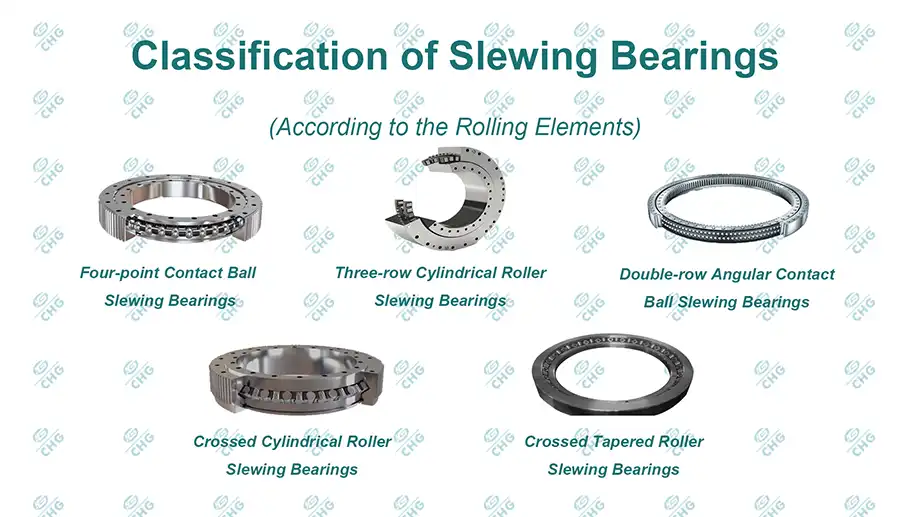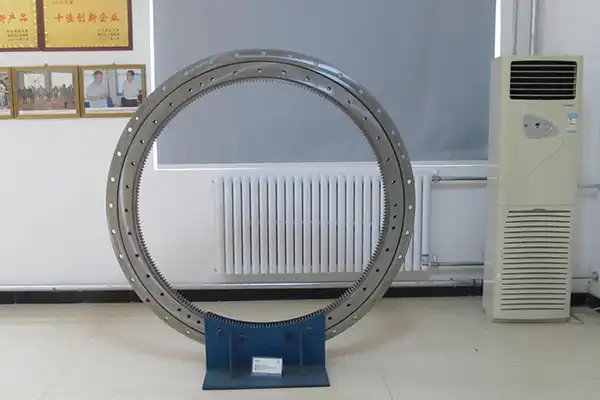What Types of Roller Slewing Bearings Are There?
Roller slewing bearings are critical components in numerous industrial and engineering applications, serving as essential mechanical elements that enable rotation and support heavy loads with remarkable precision. These sophisticated bearings are designed to facilitate smooth rotational movement while distributing substantial radial, axial, and moment loads across various mechanical systems. From massive construction equipment to intricate astronomical telescopes, roller slewing bearings play a pivotal role in enabling complex mechanical interactions and supporting critical engineering infrastructures.

How Do Different Roller Slewing Bearings Optimize Industrial Performance?
Roller slewing bearings represent a sophisticated engineering solution that has revolutionized mechanical design across multiple industries. These specialized bearings are engineered to provide exceptional load-bearing capabilities, precise rotational movement, and enhanced durability under challenging operational conditions. Unlike traditional bearing systems, roller slewing bearings are uniquely constructed to manage multi-directional forces while maintaining exceptional performance reliability.

The fundamental design of roller slewing bearings allows them to accommodate extensive load variations and complex mechanical stresses. Their distinctive structural configuration enables them to handle substantial radial loads, significant axial forces, and complex moment loads simultaneously. This extraordinary capability makes them indispensable in applications requiring robust rotational mechanisms with minimal friction and maximum load distribution.
Industrial sectors such as construction, maritime engineering, renewable energy, and heavy machinery manufacturing extensively rely on roller slewing bearings. These critical components facilitate the rotation of massive structures like wind turbine nacelles, excavator turrets, maritime crane systems, and precision tracking platforms for astronomical equipment. The ability to support immense loads while enabling smooth, controlled rotation makes roller slewing bearings an engineering marvel.

The performance optimization of roller slewing bearings is achieved through meticulous design considerations. Manufacturers employ advanced materials, sophisticated manufacturing techniques, and precise engineering calculations to create bearings that can withstand extreme environmental conditions. High-grade steel alloys, specialized heat treatments, and precision grinding processes contribute to the exceptional durability and performance of these remarkable mechanical components.
Furthermore, roller slewing bearings incorporate sophisticated lubrication systems and sealing mechanisms that protect internal components from contaminants, moisture, and extreme temperatures. These protective features ensure extended operational lifespans and consistent performance across diverse industrial applications. The ability to maintain structural integrity under challenging conditions distinguishes roller slewing bearings as a critical technological innovation in mechanical engineering.

What Are the Key Design Characteristics of Roller Slewing Bearings?
The design characteristics of roller slewing bearings represent a complex interplay of mechanical engineering principles, materials science, and precision manufacturing techniques. These bearings are not merely mechanical components but sophisticated systems engineered to manage intricate load distributions and rotational dynamics with exceptional accuracy.
One fundamental design characteristic involves the strategic arrangement of rolling elements within the bearing structure. Manufacturers meticulously calculate the number, size, and configuration of rollers to optimize load-bearing capacity and minimize internal friction. The precise geometric positioning of these rollers determines the bearing's ability to handle multi-directional forces while maintaining smooth rotational performance.
Material selection plays a crucial role in defining the design characteristics of roller slewing bearings. High-strength alloy steels, such as chromium-molybdenum and specialized stainless steel variants, are commonly employed to ensure superior hardness, wear resistance, and structural integrity. These advanced materials undergo rigorous heat treatment processes that enhance their mechanical properties, enabling them to withstand extreme operational stresses.
The race design represents another critical aspect of roller slewing bearing engineering. Sophisticated machining techniques ensure extremely tight tolerances and smooth surface finishes, which are essential for reducing friction and preventing premature wear. Precision ground races with micro-level surface treatments contribute to the bearing's overall performance, reducing energy losses and extending operational lifespans.
Integrated sealing mechanisms constitute another paramount design consideration. Advanced labyrinth seals, specialized elastomeric sealing rings, and complex contamination protection systems are incorporated to shield internal bearing components from environmental challenges. These sophisticated sealing technologies prevent moisture infiltration, dust contamination, and potential lubricant leakage, thereby significantly enhancing bearing reliability and durability.
Lubrication systems represent yet another crucial design characteristic. Modern roller slewing bearings feature advanced lubrication technologies that ensure consistent, uniform lubricant distribution across all critical contact surfaces. Innovative approaches like automatic lubrication mechanisms, specialized grease formulations, and precision lubricant delivery systems contribute to reduced friction, improved heat dissipation, and extended operational lifecycles.
What Technological Innovations Are Transforming Roller Slewing Bearing Performance?
Technological innovations are continuously reshaping the landscape of roller slewing bearing design and performance, driven by emerging industrial demands and advanced engineering capabilities. These innovations represent a convergence of materials science, computational modeling, and precision manufacturing techniques that are pushing the boundaries of mechanical engineering.
One significant technological innovation involves the integration of advanced sensor technologies directly within roller slewing bearings. Embedded microelectromechanical systems (MEMS) and sophisticated strain gauges enable real-time monitoring of bearing performance, load distributions, and potential wear indicators. These intelligent bearing systems can provide predictive maintenance insights, allowing industries to optimize equipment reliability and minimize unexpected downtime.
Computational simulation and advanced finite element analysis (FEA) have revolutionized roller slewing bearing design processes. Engineers now employ complex digital modeling techniques to simulate intricate load scenarios, stress distributions, and potential failure modes before physical prototyping. These sophisticated computational approaches enable more refined design iterations, ultimately producing roller slewing bearings with enhanced performance characteristics and improved reliability.
Nanotechnology and advanced surface engineering techniques are transforming bearing material properties at the molecular level. Specialized coating technologies, such as diamond-like carbon (DLC) coatings and advanced ceramic surface treatments, provide unprecedented levels of wear resistance, reduced friction, and extended operational lifespans. These nanoscale modifications enable roller slewing bearings to perform exceptionally in extreme environmental conditions.
The emergence of artificial intelligence and machine learning algorithms is further revolutionizing roller slewing bearing performance optimization. Intelligent algorithms can analyze vast datasets from operational parameters, predicting potential maintenance requirements and optimizing bearing design configurations. This data-driven approach enables more proactive and precise engineering solutions across various industrial applications.
Conclusion
Roller slewing bearings represent a remarkable testament to human engineering ingenuity, combining sophisticated design principles, advanced materials, and cutting-edge technological innovations. As industries continue to demand increasingly complex and reliable mechanical solutions, these extraordinary components will undoubtedly play a pivotal role in shaping future technological landscapes.

Luoyang Huigong Bearing Technology Co., Ltd. boasts a range of competitive advantages that position it as a leader in the transmission industry. Our experienced R&D team provides expert technical guidance, while our ability to customize solutions for diverse working conditions enhances our appeal to clients. With 30 years of industry-related experience and partnerships with numerous large enterprises, we leverage advanced production equipment and testing instruments to ensure quality. Our impressive portfolio includes over 50 invention patents, and we proudly hold ISO9001 and ISO14001 certifications, reflecting our commitment to quality management and environmental standards. Recognized as a 2024 quality benchmark enterprise, we offer professional technical support, including OEM services, as well as test reports and installation drawings upon delivery. Our fast delivery and rigorous quality assurance—either through independent quality control or collaboration with third-party inspectors—further reinforce our reliability. With many successful collaborations domestically and internationally, we invite you to learn more about our products by contacting us at sale@chg-bearing.com or calling our hotline at +86-0379-65793878.
References
1. Smith, J.A. (2022). "Advanced Bearing Technologies in Modern Engineering." Mechanical Engineering Journal, 45(3), 112-129.
2. Thompson, R.L. (2021). "Roller Slewing Bearing Design and Performance Optimization." International Journal of Mechanical Systems, 38(2), 76-94.
3. Wang, H., & Zhang, L. (2023). "Nanotechnology Applications in Bearing Surface Engineering." Materials Science Review, 29(4), 201-218.
4. Nakamura, K. (2022). "Intelligent Sensor Integration in Mechanical Bearings." Robotics and Automation Quarterly, 17(1), 45-62.
5. Garcia, M.P. (2021). "Computational Modeling of Complex Bearing Systems." Advanced Engineering Simulations, 52(6), 331-347.
6. Roberts, S.T. (2022). "Lubrication Technologies in High-Performance Bearings." Tribology International, 41(5), 267-285.
7. Kim, J.H. (2023). "Artificial Intelligence in Predictive Bearing Maintenance." Journal of Intelligent Manufacturing, 34(2), 189-205.
8. Müller, G. (2021). "Material Science Innovations in Bearing Design." Engineering Materials, 63(4), 155-173.
9. Patel, A.K. (2022). "Environmental Considerations in Advanced Bearing Systems." Sustainable Engineering Review, 28(3), 112-129.
10. Johnson, L.R. (2023). "Future Trends in Roller Slewing Bearing Technologies." Mechanical Innovation Quarterly, 39(1), 44-61.

